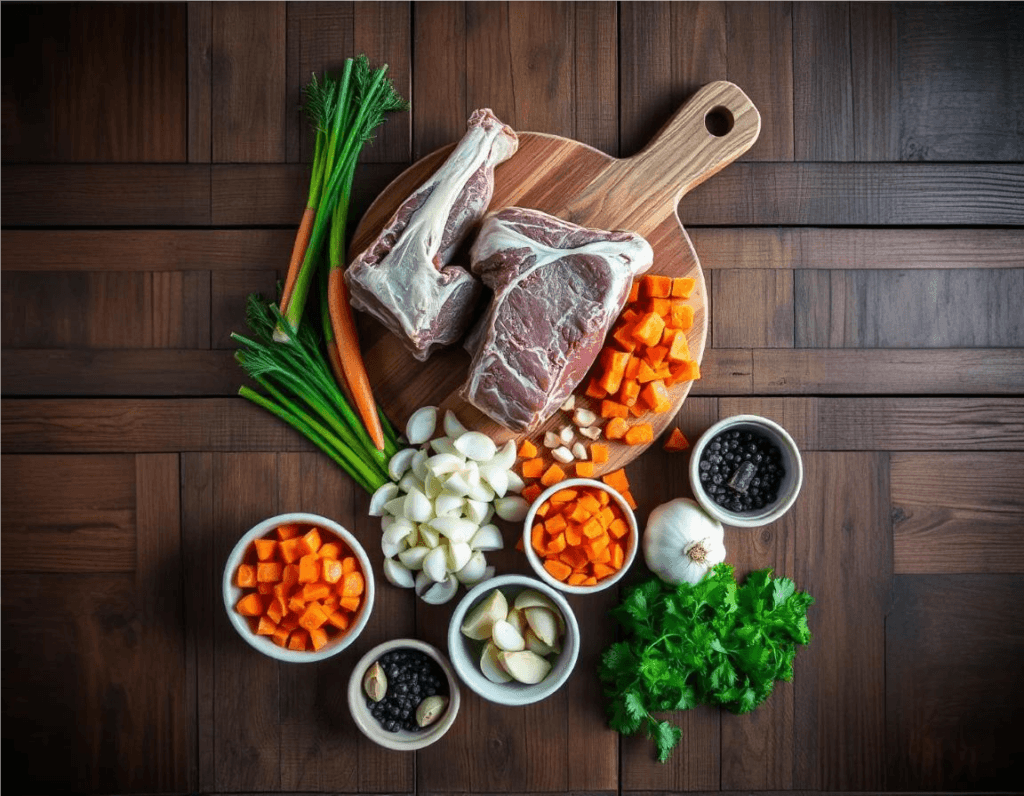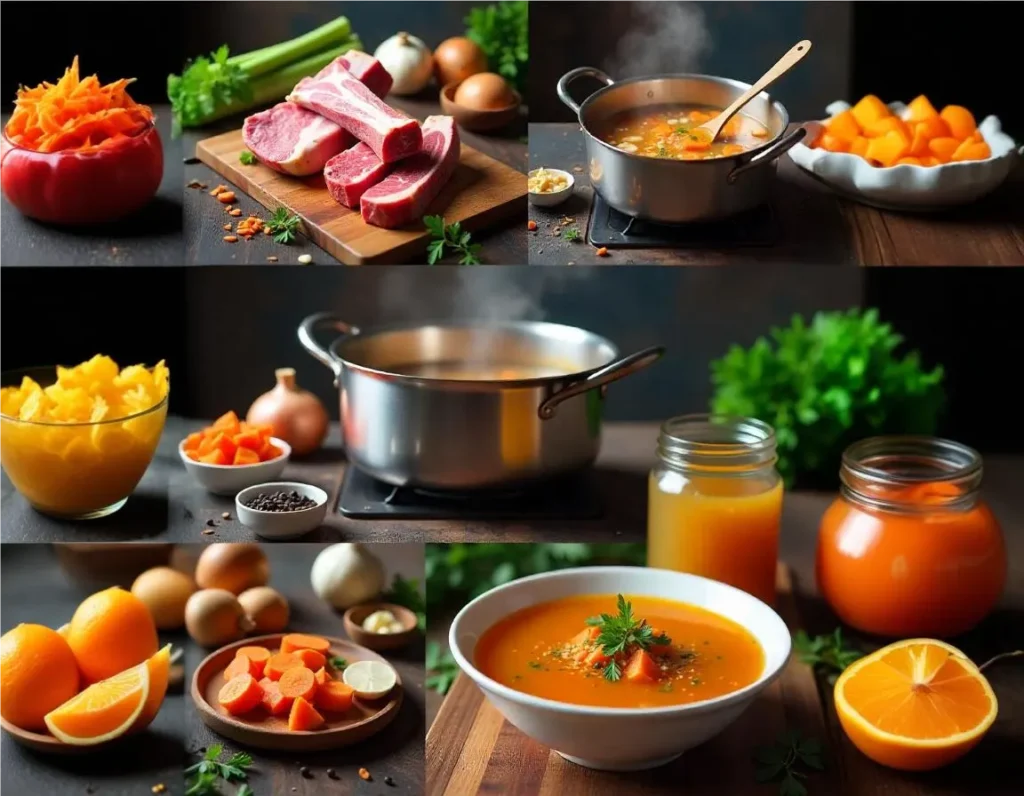I love making homemade bone broth with soup bones. It adds amazing flavor and health benefits to any dish. Whether it’s a hearty beef stew or a comforting chicken noodle soup, the key to a rich and nourishing broth is using high-quality soup bones.

In this guide, we’ll discover how to pick and prepare soup bones for the best flavor. You’ll learn about the different bones and how to get the most out of them. Soon, you’ll be making soups and stews that everyone will love.
Table of contents
Understanding Soup Bones and Their Culinary Value
Soup bones, also known as stock bones, are key for making tasty hearty soup recipes and rich best soup bones for broth. They come from beef, chicken, pork, or fish. These bones are full of bone marrow, connective tissues, and nutrients.
When simmered for a long time, they release gelatin and collagen. This makes broths silky and velvety. It makes the soup experience better.
Different Types of Soup Bones Available
The world of soup bones is full of options, each with its own benefits. Marrow bones are loved for their creamy, fatty marrow. They add deep, rich flavors to soups.
Knuckle bones are full of collagen, making broths gelatinous. Oxtail bones have both bone and meat. They add a mix of flavors that can make any dish better.
Why Quality Matters in Bone Selection
The quality of bones is crucial for hearty soup recipes and best soup bones for broth. High-quality bones come from well-fed animals. They have more nutrients and flavor.
Low-quality bones can make a broth taste bad. It lacks the depth and complexity of a great soup.
Basic Anatomy of Soup Bones
Soup bones have three main parts: the bone, marrow, and connective tissues. Each part adds something special to the broth. Choosing and preparing soup bones is an art.
Knowing how soup bones work is the first step to making hearty soup recipes and best soup bones for broth. It will impress anyone.
The Nutritional Benefits of Bone Broth Making
Enjoying a warm cup of bone broth is nourishing and restorative. It’s made by simmering soup bones. This ancient elixir is full of vitamins, minerals, and collagen-boosting compounds.
Soup bones are rich in nutrients like healthful fats, vitamins A and K, and minerals such as calcium, magnesium, and phosphorus. As a result, when they simmer, they release collagen, which, in turn, transforms into gelatin. In particular, this gelatin is great for supporting joints, improving digestion, and enhancing skin hydration.
Moreover, studies show that bone broth’s gelatin and collagen are incredibly beneficial. For instance, drinking just 300ml of bone broth can significantly boost amino acids like glycine and proline. Notably, these amino acids are essential for collagen production. In addition, collagen supplements are known to improve skin elasticity, bone density, and overall health.
Beyond that, bone broth offers even more benefits, as it aids digestion and supports gut health. Specifically, its gelatin helps food move efficiently through the intestines. Furthermore, it may even help alleviate symptoms associated with inflammatory bowel disease.
To sum up, adding homemade bone broth to your daily routine is a simple yet powerful way to nourish your joints, skin, and gut. By using soup bones, you can fully enjoy the many bone broth benefits and, ultimately, see a significant improvement in your overall well-being.
| Nutrient | Bone Broth Content |
|---|---|
| Calories | Approximately 40 calories per serving |
| Protein | 10 grams per serving |
| Sodium | 200-400 mg per serving (homemade broth is lowest in sodium) |
| Collagen | Beef bone broth contains the most collagen compared to other types |
“Homemade bone broth is considered the healthiest type due to the ability to control salt content and other ingredients.”
Essential Equipment for Preparing Soup Bones
Making delicious bone broth needs the right tools. Whether you’re a pro or just starting, knowing the key equipment helps. It makes the process easier and more efficient.
Recommended Pots and Cooking Vessels for Soup Bones
A large stock pot or Dutch oven is key. Choose one that’s at least 8 to 12 quarts. This size lets you fit all the bones and water. You can also use a slow cooker or pressure cooker for easy simmering.
Additional Tools and Utensils for Cooking Soup Bones
- Fine mesh strainer or cheesecloth: Essential for separating the broth from the cooked bones and any impurities.
- Ladle: Useful for skimming off any foam or fat that rises to the surface during the simmering process.
- Roasting pan: If you plan to roast the bones before simmering, a sturdy roasting pan will be necessary.
Storage Containers and Options for Soup Bone Broth
After making your bone broth, you’ll need good containers to store it. Wide-mouth mason jars or food-grade plastic containers are great. Make sure to leave space for expansion if you’re freezing it.
With the right tools, you’re set to make tasty soup bones for stock and easy soup bone recipes. They’ll nourish you and please your taste buds.
Selecting the Best Soup Bone for Your Recipe

Choosing the right soup bones is key to making great bone broth. Opt for bones from grass-fed or pasture-raised animals for the best flavor and nutrition. Local butchers and farmers’ markets are great places to find fresh, well-cut bones with meat still on them.
Go for marrow-filled bones or knuckle bones with visible cartilage for your broth. Mixing different bones, like beef and chicken, can add depth to your broth’s taste.
| Bone Broth | Size | Protein per Serving |
|---|---|---|
| Chicken Bone Broth by FOND | 14 oz | 6 g |
| Best Beef Bone Broth | 16 oz | 20 g |
| Best Chicken Bone Broth | 32 oz | 4 g |
| Organic Beef Bone Broth | 16.9 oz | 19 g |
| Budget-Friendly Chicken Bone Broth | 10.75 oz | 10 g |
| Frozen Bone Broth | 24 oz | 10 g |
| Best Powder Bone Broth | – | 10 g |
The quality of your soup bones greatly affects your bone broth‘s taste and nutrition. Spending on the best soup bones will make your broth rich in flavor and nutrients.
“The bones from grass-fed animals are far superior in both flavor and nutrients compared to conventional, factory-farmed sources.”
When picking soup bones, focus on quality first. The right bones and careful preparation will take your bone broth to the next level.
Pre-Cooking Preparation Techniques for Soup Bones

When cooking with soup bones, getting them ready right is crucial. Start by cleaning the bones well to get rid of any dirt or blood. This step can greatly improve your homemade bone broth’s taste and clarity.
Proper Cleaning and Handling Methods for Soup Bones
First, rinse the bones under cold water and scrub them with a brush. This removes any dirt. Then, dry the bones with paper towels to prepare them for the next step.
Roasting vs. Blanching Soup Bones: Which Is Better?
Choosing between roasting or blanching the bones affects your broth’s taste. Roasting at 425°F (220°C) for 30-45 minutes makes the bones sweeter and richer. Blanching, on the other hand, boils the bones for 5-10 minutes to remove impurities and unwanted flavors.
Seasoning and Aromatics for Flavorful Soup Bone Broth
After prepping the bones, think about your seasonings and aromatics. Onions, garlic, carrots, celery, bay leaves, peppercorns, and herbs like thyme or parsley are good choices. Adding 1-2 teaspoons of apple cider vinegar or lemon juice can also help extract more minerals from the bones.
By using these simple steps, you’ll make a delicious and healthy broth. This broth will make your soups, stews, and other dishes even better.
Traditional Cooking Methods and Times for Soup Bones
Preparing the perfect slow-cooked soup bone recipes starts with the stove-top method. This method involves simmering bones in cold water for 6 to 24 hours. First, bring the pot to a boil, then lower the heat for a gentle simmer.
In the first 30 minutes, skim off any impurities that rise. This step guarantees a clear, flavorful soup bone recipe. Keep the bones fully submerged by adding more water as needed.
The slow simmering process extracts nutrients and flavor from the bones. This results in a rich, gelatinous broth. You can use this broth for soups, stews, sauces, and marinades.
| Cooking Method | Yield | Cooking Time | Broth Color and Flavor |
|---|---|---|---|
| Stove-top | 6 cups | 12-36 hours | Middle-ground color and taste |
| Instant Pot | 10 cups | 2 1/2 hours | Best for time, taste, and yield |
| Slow-cooker | 10 cups | 18-24 hours | Darkest broth with beefiest taste and complex flavors |
The traditional stove-top method may take longer, but it’s worth it. The slow process extracts the most nutrients and flavor. This creates a slow-cooked soup bone recipe that’s truly exceptional.
“The best chicken stock is made from chicken carcasses containing bone and meat, creating a gelatinous texture when cooled.”
Using Modern Appliances for Bone Broth
Modern appliances can be your best friends when cooking soup bones and making bone broth. Tools like slow cookers and pressure cookers make the process easier. They help you get the most flavor and nutrients from your easy soup bone recipe.
Slow Cooker Techniques for Soup Bones
Slow cookers are great for how to cook with soup bones. Just add bones, water, and aromatics, then set it on low. Let it simmer for 12-24 hours. This slow cooking breaks down collagen and releases flavors, making a rich and nutritious broth.
Pressure Cooker Guidelines for Soup Bones
Pressure cookers are perfect for those in a hurry. They cook bones quickly under high pressure. This method can make delicious bone broth in just 2-3 hours. It’s fast and efficient, making it ideal for busy cooks.
Temperature and Timing Controls
For slow cookers, use the low setting for 8-10 hours. For pressure cookers, cook on high pressure for 2-3 hours. Both methods effectively extract flavors and nutrients from bones. Pressure cooking is the quicker option.
Investing in modern appliances like slow cookers and pressure cookers can make making bone broth easier. These tools save time and help you enjoy a delicious and healthy easy soup bone recipe. Try them out and see the difference in your how to cook with soup bones creations.
Straining and Storing Your Soup Bone Broth
After simmering your homemade bone broth, it’s time to strain and store it. This step is key to keeping your broth flavorful and nutritious.
Begin by straining the broth through a fine mesh sieve or cheesecloth. This removes bones, vegetables, and herbs, leaving a clear broth. For an even smoother texture, you can strain it again.
Let the broth cool to room temperature before storing. This prevents harmful bacteria from growing. Once cooled, move the broth to airtight containers or freezer-safe bags.
Refrigerated, your bone broth lasts 3-4 days. For longer storage, freeze it in portions using ice cube trays or small bags. This makes it easy to thaw and use in recipes or for sipping.
Proper storage is crucial for keeping your bone broth nutritious and flavorful. By following these steps, you can enjoy homemade bone broth for months.
Common Mistakes to Avoid When Preparing Soup Bone
Making a tasty soup bone broth is an art. Avoiding common mistakes can make a big difference. Whether you’re experienced or new to soup bone recipes, avoiding these errors will help you get the broth you want.
One big mistake is rushing the simmering process. Historians say soup-making goes back to 20,000 B.C. The secret to a great soup bones broth is slow, patient cooking. Letting your broth simmer for a long time gets more gelatin and flavor.
Another mistake is using warm or hot water. Cold water from the tap is best. It pulls out more minerals and collagen from the bones. Also, add a bit of acid, like apple cider vinegar, to get even more nutrients.
- Avoid oversalting during cooking. Season your broth with salt at the end or when using it in recipes. Too much salt can ruin the taste.
- Don’t throw away the fat layer that forms on top of the cooled broth. This layer keeps the broth fresh and adds flavor to your dishes.
By avoiding these mistakes, you’ll make a soup bone broth that’s rich, flavorful, and full of goodness. Learning to prepare soup bones is rewarding. These tips will guide you on this journey with confidence.
FAQs:
What is a soup bone?
A soup bone is, essentially, a bone from beef, pork, or lamb that is specifically used to add flavor, nutrients, and richness to soups, broths, or stews. Typically, these bones contain some meat, connective tissue, and, most importantly, marrow. As a result, when they are simmered for an extended period, they release a deep, savory flavor and beneficial gelatin into the liquid. Furthermore, soup bones are commonly used to make bone broth or stock, which serves as an excellent base for hearty dishes like soups, sauces, and gravies.
What is a soup bone slang?
Interestingly, in slang terms, a soup bone refers to a large joint or bone, such as a person’s elbow. Moreover, it is sometimes used humorously to describe a strong punch, especially in informal or older dialects. For instance, one might hear, “He swung his soup bone and knocked him over!” As a matter of fact, this quirky usage highlights how everyday items often find their way into colorful language.
Are soup bones good to eat?
Yes, soup bones are indeed good for cooking; however, they are not typically eaten directly. For one thing, the meat and marrow attached to the bones provide incredible flavor and nutrients when simmered in soups or broths. In addition, while the bone itself is inedible, the nutrients released during slow cooking—such as collagen, gelatin, and minerals—are extremely beneficial for health. Furthermore, the bone marrow, which is the soft, fatty substance inside the bone, can be scooped out after cooking and enjoyed as a rich, buttery delicacy.
Are soup bones the same as bone marrow?
Although soup bones and bone marrow are closely related, they are not exactly the same. To clarify, soup bones refer to whole bones, which often include meat, connective tissue, and, sometimes, marrow. On the other hand, bone marrow is specifically the soft, fatty substance found inside the bone. In many cases, soup bones contain marrow, which boosts the flavor and nutrition of the broth. Nevertheless, bone marrow itself can be removed and consumed separately as a nutritious and flavorful ingredient, making it a highly prized delicacy.
Conclusion: Mastering the Art of Soup Bone Preparation
Creating homemade hearty soup recipes with the best soup bones for broth is a rewarding journey. It makes rich, flavorful bases for your dishes. By choosing the right bones, preparing them well, and cooking them right, you get a broth full of collagen and minerals.
Whether you start fresh or use leftover bones, getting good at soup bone prep makes your cooking better. It brings deeper, more satisfying flavors to every bite. Knowing about different bones and how to cook them well is key to making great broth.
By mixing old traditions with new tech, you can make your soup bones and broths even better. This journey will make your soup recipes more delicious and nutritious. Start this adventure and take your soup recipes to new heights.




